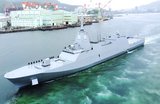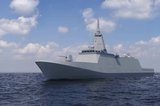Naval Warfare magazine: Ship-to-shore connectors, vessel automation, global frigate market and more
Read the latest edition of Naval Warfare for free in our app or on your desktop. Register below to be sent the download link and receive future editions direct to your inbox.
Comment
The COVID-19 pandemic combined with the Integrated Review will likely deal a double blow to the UK RN and might have a lasting impact on the service.
Features include:

TOO CLOSE FOR COMFORT?
Close-in weapon systems form the last line of defence for surface combatants, tackling inbound threats that have penetrated the outer layers. Shephard examines how these prevalently gun-based solutions are evolving to remain effective in the contemporary operating environment.
Other features include:
COMBAT CONNECTORS
A key aspect of amphibious assault is getting deployed personnel, their vehicles and equipment ashore quickly and safely. Shephard examines the vital connective craft that fulfil this role with the world’s major navies.
DEGREES OF CONTROL
While mechanical automation has been baked into warship design for decades, saving labour and reducing risk to crew, the integration of more data and higher levels of autonomy could take the basic principle to the next stage of evolution.
OCEANS APART?
The Russian surface combatant fleet is undergoing transformation in order to allow the service to maintain a sufficient blue-water capability in the medium term, but big ambitions for establishing a powerful ocean-going force have so far received limited support.
BALANCED CAPABILITY
A shift towards a mixture of high-end designs and modular, cheaper vessels to maintain fleet numbers is defining the global frigate market for the 2020s. Shephard Defence Insight analyses the key programmes and headline numbers.
ACCESS DENIED?
Modern naval vessels and unmanned maritime systems rely extensively on GPS and other satellite-based navigation aids. But what happens when the signal is lost or disrupted, whether by environmental factors or hostile action?
THE SILENT SERVICE
Despite limited budgets, Latin American nations continue to aspire to field submarine fleets. Shephard investigates the capabilities, mission sets and future of these assets within the region.

More from Naval Warfare
-
![NATO tests use of “undetectable, jam-proof” laser communication in maritime scenarios]()
NATO tests use of “undetectable, jam-proof” laser communication in maritime scenarios
As part of its effort to better prepare its capabilities for operations in contested and congested scenarios, NATO evaluated a Lithuanian ship-to-ship terminal designed to not be susceptible to enemy interference.
-
![Future of the Canadian Patrol Submarine Project is still unclear]()
Future of the Canadian Patrol Submarine Project is still unclear
The Canadian government remains tight-lipped on the timeline and funding required for the next steps of its Canadian Submarine Patrol Project, which should offer improved capabilities for the country’s navy.
-
![Mitsubishi eyes future with Australia’s Mogami selection]()
Mitsubishi eyes future with Australia’s Mogami selection
With Australia’s selection of the Mogami-class for Project Sea 3000, Mitsubishi is investigating local production in the next decade as potential export opportunities emerge.
-
![Thales’ new Sonar 76Nano could equip UK Royal Navy on anti-submarine warfare missions]()
Thales’ new Sonar 76Nano could equip UK Royal Navy on anti-submarine warfare missions
The new sonar is designed to equip uncrewed underwater vessels, with the potential to be used by the Royal Navy for its Atlantic Bastion and Atlantic Net missions.























